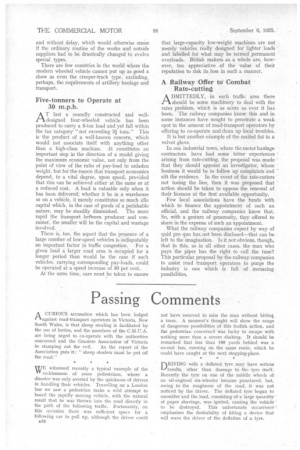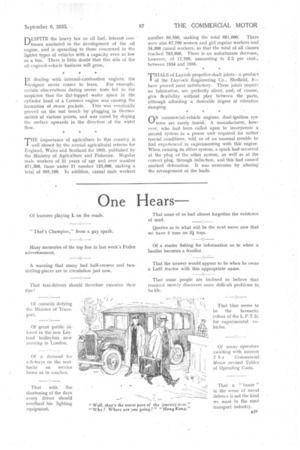Passing Comments
Page 32

Page 33

If you've noticed an error in this article please click here to report it so we can fix it.
A CURIOUS accusation which has been lodged clagainst road-transport operators in Victoria, New South Wales, is that sheep stealing is facilitated by the use of lorries, and the members of the C.M.U.A. are being urged to co-operate with the authorities concerned and the Graziers Association of Victoria
in stamping out the evil. As the report of the Association puts it: " sheep stealers must be put off the road."
WE witnessed recently a typical example of the " recklessness of some pedestrians, where a disaster was only averted by the quickness of drivers in handling their vehicles. Travelling on a London bus we saw a pedestrian make a wild attempt to board the rapidly moving vehicle, with the natural result that he was thrown into the road directly in the path of the following traffic. Fortunately, on this occasion there was sufficient space for a following car to pull up, although the driver could n18
not have swerved to miss the man without hitting a tram. A moment's thought will show the range of dangerous possibilities of this foolish action, and the pedestrian concerned was lucky to escape with nothing more than a severe shaking. It should be remarked that less than 100 yards behind was a -second bus, running on the same route, which he could have caught at the next stopping-place.
DRIVING with a deflated tyre may have serious results, other than damage to the tyre itself. Recently the tyre on one of the middle wheels of an oil-engined six-wheeler became punctured, but, owing to the roughness of the road, it was not noticed by the driver. The deflated tyre began to smoulder and the load, consisting of a large quantity of paper shavings, was ignited, causing the vehicle to be destroyed. This unfortunate occurrence emphasizes the desirability of fitting a device that will warn the driver of the deflation of a tyre. DESPITE the heavy tax on oil fuel, interest continues unabated in the development of the oil engine, and is spreading to those concerned in the lighter types of vehicles with a capacity even as low as a ton. There is little doubt that this side of the oil-engined-vehicle business will grow.
IN dealing with internal-combustion engines, the 'designer never ceases to learn. For example, certain obs€ rvations during severe tests led to the suspicion that the flat-topped water space in the cylinder head of a Comme.r engine was causing the formation of steam pockets. This was eventually proved on the test bench by plugging in thermometers at various points, and was cured by sloping the surface upwards in the direction of the water flow.
THE importance of agriculture in this country is well shown by the annual agricultuial returns for England, Wales and Scotland for 1935, published by the Ministry of Agriculture and Fisheries. Regular male workers of 21 years of age and over number 471,300, those under 21 number 123,800, Making a total of 595,100, In addition, casual male workers
number 86,500, making the total 681,600. There were also 67,700 women and girl regular workers and 34,300 casual workers; so that the total of all classes reached 783,600. There is an unfortunate decrease, however, of 17,700, amounting to 2.2 per cent., between 1934 and 1935.
TRIALS of Layrub propeller-shaft joints—a product I of the Laycock Engineering Co., Sheffield, Shave proved most satisfactory. These joints require no lubrication, are perfectly silent, and, of course, give flexibility without play between the parts, although affording a desirable degree of vibration damping.
ON commercial-vehicle engines, dual-ignition systems are rarely found. A manufacturer, however, who had been called upon to incorporate a second system in a power unit required for rather special conditions, told us of an unusual trouble he had experienced in experimenting with this engine. When running On either system, a spark had occurred at the plug of the other system, as well as at the correct plug, through induction, and this had caused marked detonation. It was overcome by altering the arrangement of the leads,




























































































